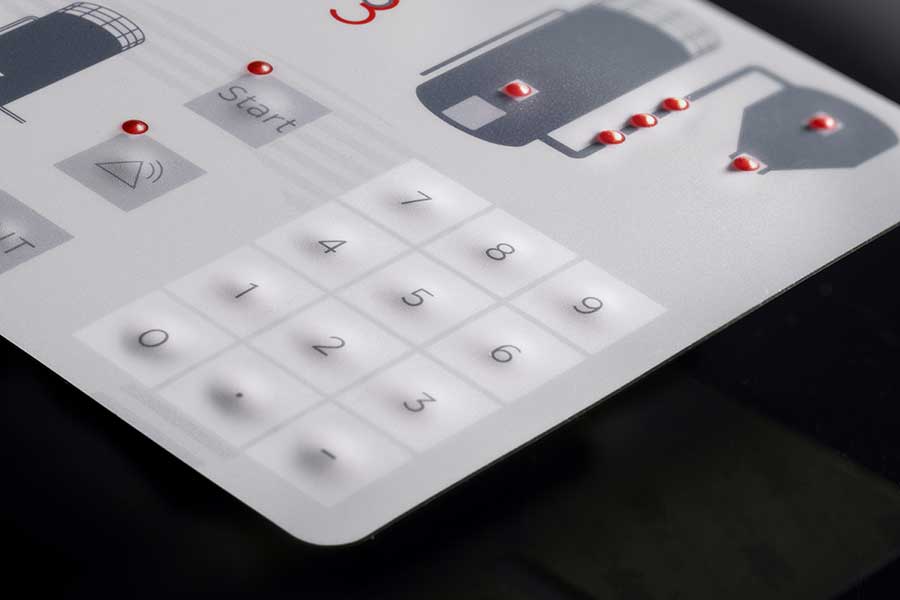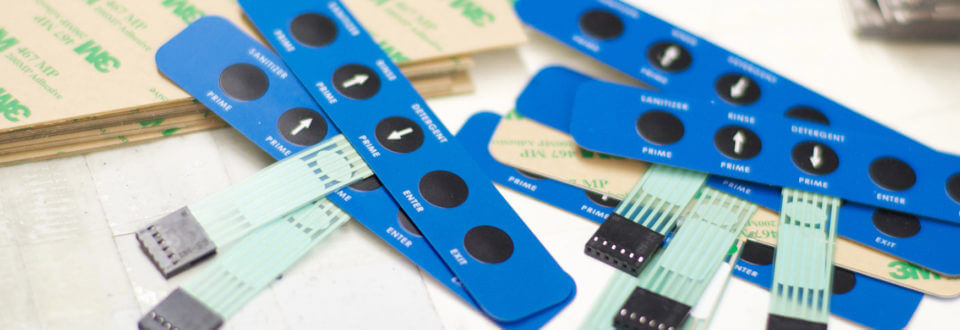How to Choose the Right Membrane Switch for Your Next Project
How to Choose the Right Membrane Switch for Your Next Project
Blog Article
Recognizing Membrane Layer Switches: The Key to Long Lasting and Reputable Controls
Membrane switches over represent a crucial aspect of contemporary interface design, blending functionality with strength in various applications. These flexible elements not just assist in user interaction but are likewise engineered to endure the rigors of requiring settings, from medical devices to commercial equipment. Recognizing their building and construction, procedure, and the myriad benefits they provide is important for engineers and developers alike. As we explore the details of membrane buttons, it becomes clear that their duty in enhancing control systems is both extensive and intricate, increasing inquiries regarding just how best to utilize their capabilities in future technologies.
What Are Membrane Layer Buttons?
Membrane buttons are an innovative service in the world of interface innovation, incorporating functionality and style effortlessly. These tools act as a user interface in between users and electronic systems, integrating several components into a small style. Commonly constructed from flexible, thin layers of materials, membrane buttons are made to reply to touch, enabling users to engage with equipment and digital devices successfully.
The key components of a membrane switch include a published circuit layer, graphic overlay, and a spacer layer that avoids unplanned activation. The graphic overlay can be customized to mirror brand name identification or individual choices, enhancing visual appeals while guaranteeing usability. Membrane buttons are generally made use of in various applications, including clinical devices, consumer electronics, and industrial tools, owing to their resilience and resistance to environmental factors such as dampness and dirt.
One of the vital benefits of membrane layer buttons is their ability to withstand damage, making them excellent for high-traffic atmospheres. Additionally, they are light-weight and need very little space, permitting cutting-edge styles in product development. Overall, membrane layer switches over represent a efficient and sensible selection for modern-day digital user interfaces, marrying technology with user-centric layout principles.

Just How Membrane Switches Work
The operation of membrane layer changes rest on a simple yet efficient device that equates individual input right into electronic signals. These switches include multiple layers, generally including a graphic overlay, a spacer layer, and a circuit layer. When a user presses the button, the top layer deforms, enabling a conductive element in the circuit layer to make contact with a matching conductive pad on the underside of the graphic overlay. This contact closes the circuit and sends out a digital signal to the tool, showing that the switch has been activated.
The design of membrane switches can differ, yet they frequently include domes or tactile components to offer responses to the user, improving the total experience. The materials made use of in membrane switches, such as polyester or polycarbonate, add to their toughness and resistance to environmental elements, including wetness and dirt. The published circuits are generally enveloped, which protects them from wear and tear over time.

Benefits of Membrane Buttons
One of the primary benefits of membrane layer switches is their flexibility in layout, enabling them to be customized to meet certain individual needs and visual requirements. This adaptability reaches different sectors, where different forms, sizes, and shades can be employed to boost user communication and aesthetic charm.
In addition, membrane buttons are understood for their resilience. Created from robust products, they are resistant to dirt, moisture, and physical wear, which dramatically prolongs their life-span compared to typical mechanical switches. This resilience makes them specifically appropriate for high-traffic environments and applications calling for durability.

Moreover, membrane layer buttons provide a streamlined profile, bring about a thinner layout that can be incorporated More Info into various tools without adding bulk. This attribute not just enhances the visual allure but additionally adds to a more ergonomic product design.

Applications of Membrane Switches
Functional and user-friendly, membrane switches discover applications throughout a vast range of markets, consisting of clinical tools, consumer electronics, and industrial devices. In the clinical field, these buttons are integral to gadgets such as analysis equipment, client tracking systems, and mixture pumps, where integrity and convenience of cleaning are vital. Their capability to maintain and endure extreme atmospheres capability makes them ideal for such applications.
In consumer electronics, membrane buttons are made use of in products like microwaves, cleaning machines, and remote controls - membrane switch. Their sleek design allows for user-friendly interface, improving the total customer experience while giving resilience and resistance to tear and use
Commercial tools also takes advantage of membrane switches, specifically in control panels for machinery and automation systems. These buttons offer security versus dirt and dampness, guaranteeing constant performance in visit their website challenging settings. Their adjustable features allow makers to tailor them to certain operational demands, improving performance and performance.
Choosing the Right Membrane Layer Switch Over
When picking a membrane layer switch, it is crucial to take into consideration numerous aspects that influence efficiency and viability for particular applications. The main considerations include ecological problems, responsive comments, durability, and design specs.
First, examine the operating setting; buttons exposed to dampness, chemicals, or extreme temperature levels call for certain products to guarantee long life and functionality. Next off, review the need for tactile responses. Depending upon user communication, some applications might take advantage of a responsive response to confirm activation, while others may choose a non-tactile style for aesthetic reasons.
Toughness is an additional crucial aspect; membrane layer buttons should be made to hold up against constant usage, influences, and abrasion. Ensure the selected switch can endure the expected lifecycle, especially in high-usage situations.
Final Thought
In verdict, membrane layer switches over offer as essential components in the style of trustworthy and long lasting control systems across different markets. The flexibility of membrane changes enables for customized options that fulfill details functional demands, enhancing their value in contemporary technology.
Membrane switches represent a vital element of contemporary interface layout, mixing performance with resilience in various applications.Membrane layer switches are a sophisticated remedy in the world of customer interface modern technology, incorporating performance and layout flawlessly. Typically built from versatile, slim layers of products, membrane buttons are developed to respond to touch, enabling individuals to connect with equipment and electronic tools properly.
The design of membrane switches can vary, but they usually integrate domes or responsive components to give feedback to the individual, improving the general experience.In verdict, membrane changes serve as necessary components in the layout of sturdy and reputable control systems throughout different industries.
Report this page